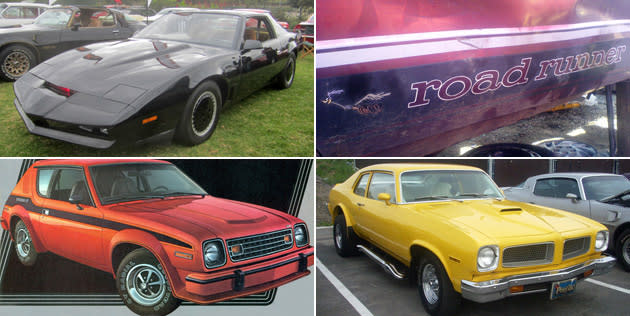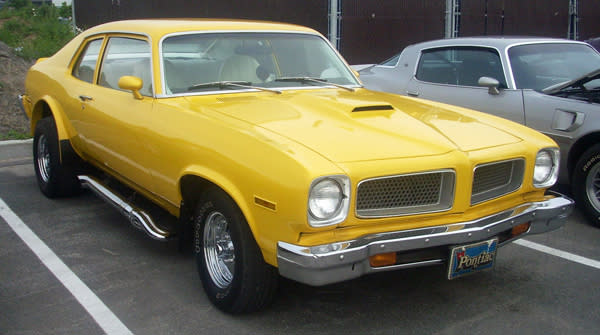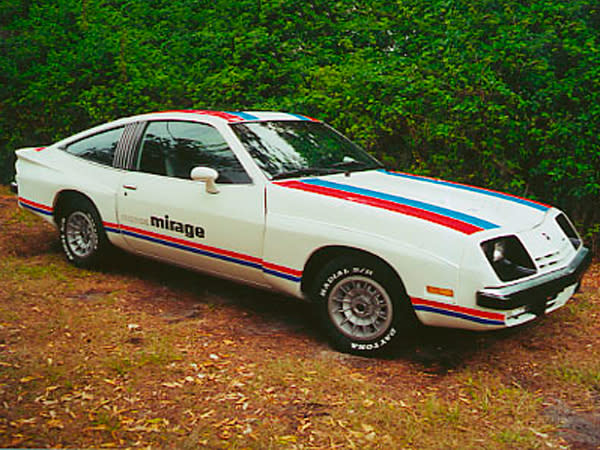10 wimpiest muscle cars ever

MORE AT POPULAR MECHANICS
There's a dead zone in the history of performance cars between the hairy-chested muscle cars of the 1960s and the rebirth of power in the mid-1980s: the 1972–82 "malaise era," when machines were so strangled by new emissions rules that their performance levels were an embarrassment to even today's compact cars. Automakers slathered flashy paint and taped racy stripes and stickers to the hoods of the cars, but these 10 just couldn't get'er done at the dragstrip.

1978 Ford Mustang King Cobra
Ford's legendary performance car hit its nadir with the downsized Pinto-based Mustangs of 1974–1978, called Mustang II. Although this generation of Mustang came with a V-8, it was a 302 cid V-8 with a mere 139 hp. Yes, you read that right. Second-gen Mustangs pumped out just 19 more hp than you'd get from the 1.6-liter four-cylinder in today's Ford Fiesta.
But that's not the most embarrassing part of the Mustang II. That would belong to the rare one-year-only 1978 Mustang King Cobra. The Cobra name should have been kept off junk like this, but Ford had already resurrected the "Cobra" name as a sticker and spoiler package for 1976. The '78 King Cobra got some really special performance enhancements, such as a hood snake decal, even more stripes, and 13-inch "Lacy" aluminum wheels. You could buy the King Cobra in black with gold trim—an obvious attempt to lure would-be Trans Am buyers. But with a deficit of 81 hp compared with the top Trans Am, the Ford wasn't much of a threat. Thankfully the all-new 1979 Fox Mustang would kill the King Cobra and mark the return for Ford performance.

1974 Pontiac GTO
The '64 Pontiac GTO is widely regarded as the first muscle car. The performance formula was simple: Drop a big 325-hp 389-cid V-8 (348 hp with Tri-Power carburetion) into a relatively small Tempest chassis and you've got a seriously quick car. The GTO went from option package to becoming its own model, and horsepower officially peaked with the 370-hp Ram Air IV V-8. (Unofficially, the big 455 High-Output (HO) of the early 1970s reportedly reached the 400-hp plateau.)
The GTO name became an option package for the Le Mans in 1973 with the top motor, a detuned 455 V-8, making a mere 250 hp. In 1974 the devastation hit a new low. Pontiac made the GTO tag an option on the Ventura, the brand's lame version of the Nova. Yuck. Under the hood was a 350 cid V-8 rated at just 200 hp. And aside from the shaker hood scoop and GTO lettering, it looked just like your grandmother's car.
The move flopped, and Pontiac pulled the GTO nameplate. We wouldn't see it again until the brief 2004–2006 revival.

1977 Chevy Monza Mirage
Chevy's downsized Monza coupe of 1975–1980 was based on the bones of the Vega. It was meant to be a smaller, sporty, and less-expensive alternative to the Camaro. And like just about every other "sporty" American coupe of this era, it had little performance under the hood.
In 1977 Michigan Automotive Techniques Corp offered a solution—at least a visual one. The company developed a package that included wide-body fender flares, spoilers, and striping that turned an ordinary Monza into the Monza Mirage. The Mirage looked cool, no doubt about it, aping the style of the popular IMSA Camel GT racing Monzas at the time. But performance? An anemic four-cylinder was standard. If you wanted a V-8, the only one available was the 5.0-liter you could order in any Monza. Talk about a dog—it made just 145 hp. And if you lived in California, that V-8 cranked out 135 hp—even less than the Mustang King Cobra.


 Yahoo Autos
Yahoo Autos 
